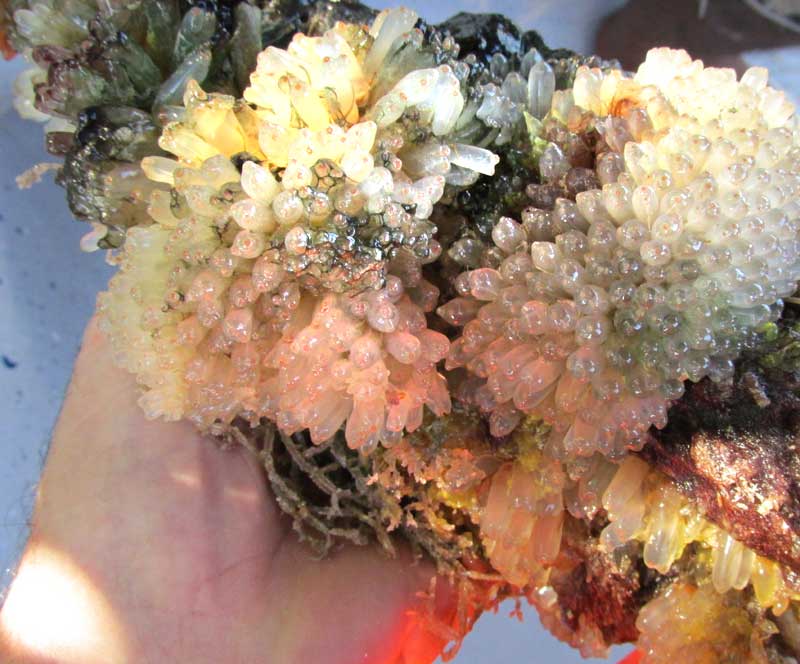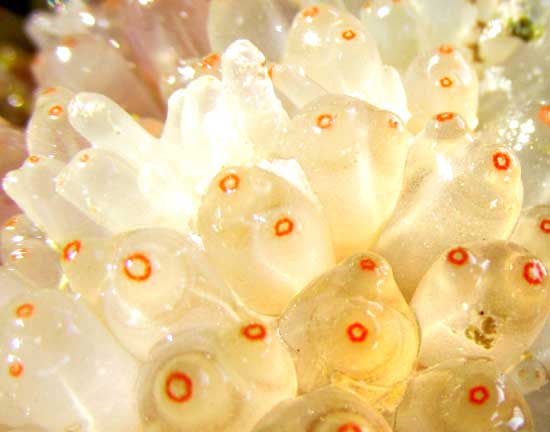Excerpts from Jim Conrad's
Naturalist Newsletter
from the November 6, 2016 Newsletter issued from Rancho Regenesis in the woods ±4kms west of Ek Balam Ruins; elevation ~40m (~130 ft), N20.876°, W88.170°; north-central Yucatán, MÉXICO
MANGROVE TUNICATES
Last week two sets of travelers visiting Genesis in Ek Balam wanted to visit Río Lagartos about 80kms north of here. Since I'd lived there for ten months, I was invited to go along with them.
On the standard Flamingo-viewing boat trip up the estuary, on the first trip we were lucky to have as our boatman Paco, with whom I've made many such trips. About midway up the estuary Paco pulled the boat to the water's edge where a tangle of Red Mangrove "stilt roots" entered the water, and pulled one of the roots from the water to show us something. So you can better visualize all this, especially the stilt roots, you might want to look at our Red Mangrove page, at www.backyardnature.net/yucatan/mang-red.htm
During all my times on the estuary I'd never thought to do this, and what Paco showed me was amazing. Below, you can see what was on a root, normally about a foot below the brackish water:

A close-up of individuals forming the white, root-covering clusters is shown beow:

Paco said that fishermen in the area think that the white objects are fish eggs, but the above photo shows that each egg-like thing bears two breast-like protuberances, and each "breast" is tipped with orange, ring-like things -- and no egg is structured like that.
The clusters are colonies of filter-feeding, marine, invertebrate animals known as "tunicates." The name tunicate applies to many genera and species in the subphylum Tunicata. To put that into some perspective, all animals with a "chordate" -- which more or less is the same as a spinal nerve -- are members of the phylum Chordata, and tunicates are subdivision of that enormous grouping. Examples of members of the Chordata range from us humans, to fish, to our lowly tunicate, which also has a primitive chordate.
Tunicates consist of a water-filled, sac-like body bearing two tubular openings known as siphons. In our photo, then, the breast-like items with their orange-rimmed openings are siphons. Water enters one siphon, food is filtered from it, and then is expelled from the other siphon. Most kinds of adult tunicates are permanently attached to rocks or other hard surfaces on the ocean floor, so our picture shows a species occupying a habitat unusual for the tunicates.
Paco wanted to show me something curious. He poked the side of a tunicate body, and a thin, clear stream of water shot a good ten inches (25cm) into the air. In fact, many tunicate species are known as sea squirts. When they feel threatened, they quickly reduce their size, and that requires getting rid of much of the water inside their bodies.
By doing a Google image search on the keywords "tunicate red mangrove roots" it was easy to identify our tunicate as the Mangrove Tunicate, ECTEINASCIDIA TURBINATA, found in warm, shallow waters of the Gulf of Mexico, including Florida, and the Caribbean. Seasonally, Mangrove Tunicates also turn up in the Mediterranean, and along the US coast they've been reported as far north as Chesapeake Bay.